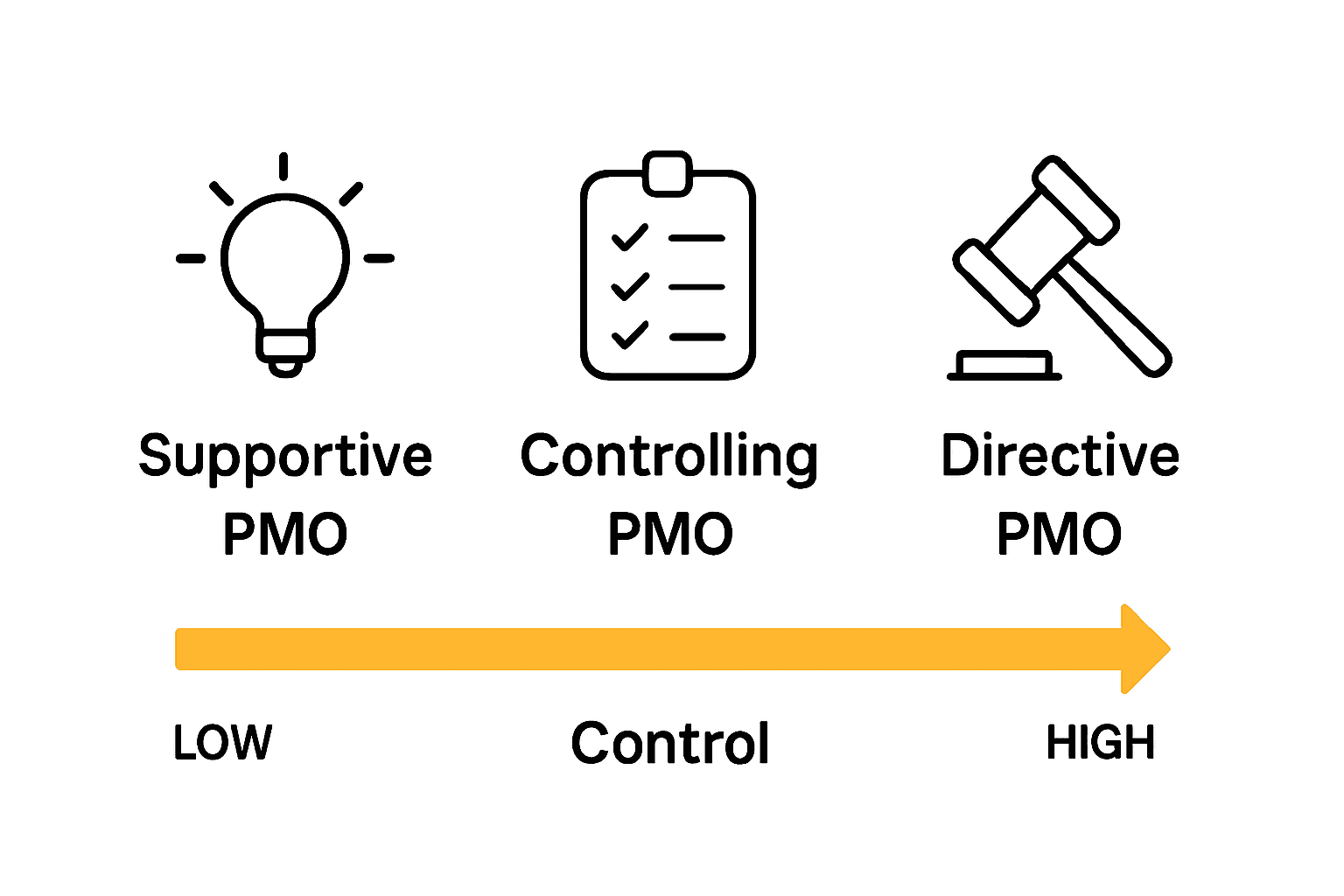Nearly 60 percent of organizations report higher project success rates after establishing a Project Management Office. As pressure mounts to deliver complex projects on time and within budget, choosing the right PMO structure can make the difference between success and costly inefficiency. Understanding how different PMO types and core functions impact your organization can help transform project management from a routine task into a true driver of strategic value.
Table of Contents
- Defining PMO and Variants
- Types of PMO and Their Distinct Roles
- Core Functions and Organizational Value
- Benefits From Establishing a PMO
- Common Pitfalls and Alternatives
Defining PMO and Variants
A Project Management Office (PMO) represents a strategic organizational unit designed to standardize and optimize project management processes across an enterprise. According to scirp.org, a PMO is “a centralized entity within an organization that defines and maintains standards for project management, aiming to standardize and introduce economies of repetition in project execution.”
The evolution of PMOs has been remarkable. en.wikipedia.org highlights that the concept originated in the 1800s with a national governance role and has since transformed into a dynamic organizational mechanism addressing specific business challenges. Modern PMOs are far more than administrative units they are strategic partners driving organizational efficiency.
PMOs typically manifest in several distinct variants, each tailored to specific organizational needs:
- Supportive PMO: Provides guidance, templates, and best practices
- Controlling PMO: Enforces compliance with project management standards
- Directive PMO: Takes direct control of project management processes
- Strategic PMO: Aligns project management with broader organizational goals
Understanding these variants allows businesses to select a PMO structure that best matches their operational complexity, industry requirements, and strategic objectives. The right PMO can transform project management from a tactical function into a powerful strategic capability.
Types of PMO and Their Distinct Roles
Organizations leverage different Project Management Office (PMO) types to address unique operational challenges. scirp.org identifies several critical PMO classifications, including Organizational Unit PMO, Project-Specific PMO, Project Support Office, Enterprise PMO, and Center of Excellence, each serving specialized organizational needs.
According to pmi.org, PMOs can be strategically classified into three primary control-oriented models:
- Supportive PMO: Provides consultative guidance and shared resources
- Controlling PMO: Establishes standardized project management methodologies
- Directive PMO: Assumes direct management and control of projects
Each PMO type offers distinct advantages depending on organizational complexity and strategic objectives. An Organizational Unit PMO might focus on departmental efficiency, while an Enterprise PMO would align project management with broad organizational goals. Project-Specific PMOs excel in managing complex, time-sensitive initiatives requiring dedicated oversight.
The Center of Excellence represents the most advanced PMO configuration, functioning as a knowledge hub that not only manages projects but also drives continuous improvement, knowledge sharing, and strategic innovation across the entire organizational ecosystem. By carefully selecting the appropriate PMO type, businesses can transform project management from a tactical function into a strategic competitive advantage.

Core Functions and Organizational Value
The Project Management Office (PMO) serves as a critical strategic nerve center for organizations, performing multifaceted functions that extend far beyond traditional administrative roles. pmi.org identifies key PMO functions including project definition, planning, cost/benefit analysis, risk management, monitoring, control, and knowledge dissemination.
According to en.wikipedia.org, PMOs play a pivotal role in strategic project management, focusing on monitoring active projects and providing crucial progress reports to top management for informed decision-making. These functions transform PMOs from mere support units into strategic partners driving organizational efficiency and innovation.

Core organizational values delivered by PMOs include:
- Standardization: Creating consistent project management methodologies
- Resource Optimization: Efficiently allocating human and financial resources
- Strategic Alignment: Ensuring projects directly support business objectives
- Risk Mitigation: Identifying and managing potential project challenges
- Performance Tracking: Providing transparent insights into project progress
By implementing robust PMO frameworks, organizations can dramatically improve project success rates, reduce operational inefficiencies, and create a culture of continuous improvement. The PMO becomes a strategic enabler, bridging the gap between tactical project execution and overarching business strategy, ultimately driving competitive advantage in an increasingly complex business landscape.
Benefits From Establishing a PMO
Establishing a Project Management Office (PMO) delivers transformative advantages for organizations seeking strategic project execution. ca.indeed.com highlights that a PMO ensures projects align precisely with company goals, dramatically increases project efficiency, reduces operational costs, and provides comprehensive quality assurance through unique performance perspectives.
pmi.org emphasizes that a well-structured PMO acts as a competitive advantage mechanism by standardizing processes, facilitating seamless knowledge sharing, and creating robust alignment between individual projects and overarching organizational strategy.
Key benefits of establishing a PMO include:
- Strategic Alignment: Ensuring project outcomes directly support business objectives
- Process Standardization: Creating consistent methodologies across project teams
- Resource Optimization: Efficiently allocating budgets, personnel, and technological resources
- Risk Management: Proactively identifying and mitigating potential project challenges
- Performance Tracking: Providing transparent, data-driven insights into project progress
By implementing a strategic PMO, organizations transform project management from a tactical function into a powerful strategic capability. The PMO becomes a central nervous system that not only executes projects but drives continuous improvement, fosters innovation, and creates a culture of disciplined, goal-oriented project delivery across the entire enterprise.
Common Pitfalls and Alternatives
Implementing a Project Management Office (PMO) is not without significant challenges. pmi.org identifies critical pitfalls that can derail PMO success, including lack of clear objectives, inadequate stakeholder engagement, and substantial organizational resistance to change.
en.wikipedia.org further highlights the complex landscape of PMO implementation, noting that organizations frequently struggle with defining precise PMO function and scope, adapting to dynamic organizational changes, and consistently demonstrating tangible value to leadership.
Common PMO implementation challenges include:
- Unclear Objectives: Failing to define specific PMO goals and expected outcomes
- Resistance to Change: Encountering internal pushback against new management processes
- Insufficient Stakeholder Buy-in: Lacking executive support and organizational alignment
- Rigid Methodology: Implementing overly prescriptive processes that limit flexibility
- Measurement Difficulties: Struggling to quantify PMO’s direct organizational impact
Alternative approaches for organizations facing PMO implementation challenges include adopting a decentralized project management model, integrating PMO functions within existing departments, or creating a hybrid approach that balances centralized guidance with departmental autonomy. Success ultimately depends on tailoring the PMO structure to the unique cultural and operational dynamics of each organization.
Transform Your PMO Challenges Into Strategic Success with Gammatica
Struggling to align your projects with business goals? The article “PMO Meaning: Everything You Need to Know” highlights common PMO pain points like unclear objectives, inefficient resource management, and resistance to change. If standardizing processes and boosting project performance feels overwhelming, you are not alone. Many organizations face these hurdles when establishing a PMO but fail to bridge the gap between tactical project execution and strategic impact.

Unlock a new level of project and team management with Gammatica. Our AI-driven platform helps you reduce administrative burdens and save valuable time through automation and intuitive task coordination. From managing workflows with Kanban boards to fostering seamless team collaboration and calendar integration, Gammatica offers the tools you need to standardize, optimize, and track project progress effortlessly. Take control of your PMO functions now by exploring powerful features designed to enhance productivity and align projects directly with your strategic objectives. Start transforming your project management challenges into measurable success today at Gammatica.com.
Frequently Asked Questions
What is a PMO?
A PMO, or Project Management Office, is a strategic organizational unit that standardizes and optimizes project management processes across an enterprise.
What are the different types of PMOs?
The main types of PMOs include Supportive PMO, Controlling PMO, Directive PMO, Strategic PMO, Organizational Unit PMO, Project-Specific PMO, Project Support Office, Enterprise PMO, and Center of Excellence, each serving unique organizational needs.
What are the core functions of a PMO?
Core functions of a PMO include project definition, planning, cost/benefit analysis, risk management, monitoring, control, and knowledge dissemination, which enhance strategic project management.
What are common challenges faced when implementing a PMO?
Common challenges include unclear objectives, resistance to change, insufficient stakeholder buy-in, rigid methodology, and measurement difficulties that can hinder PMO success.


